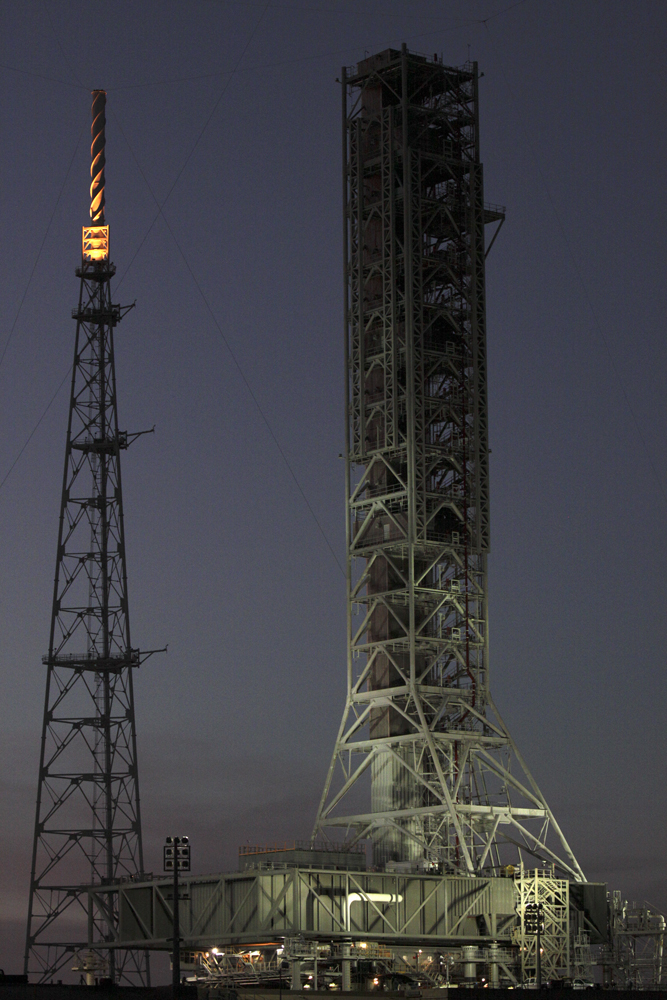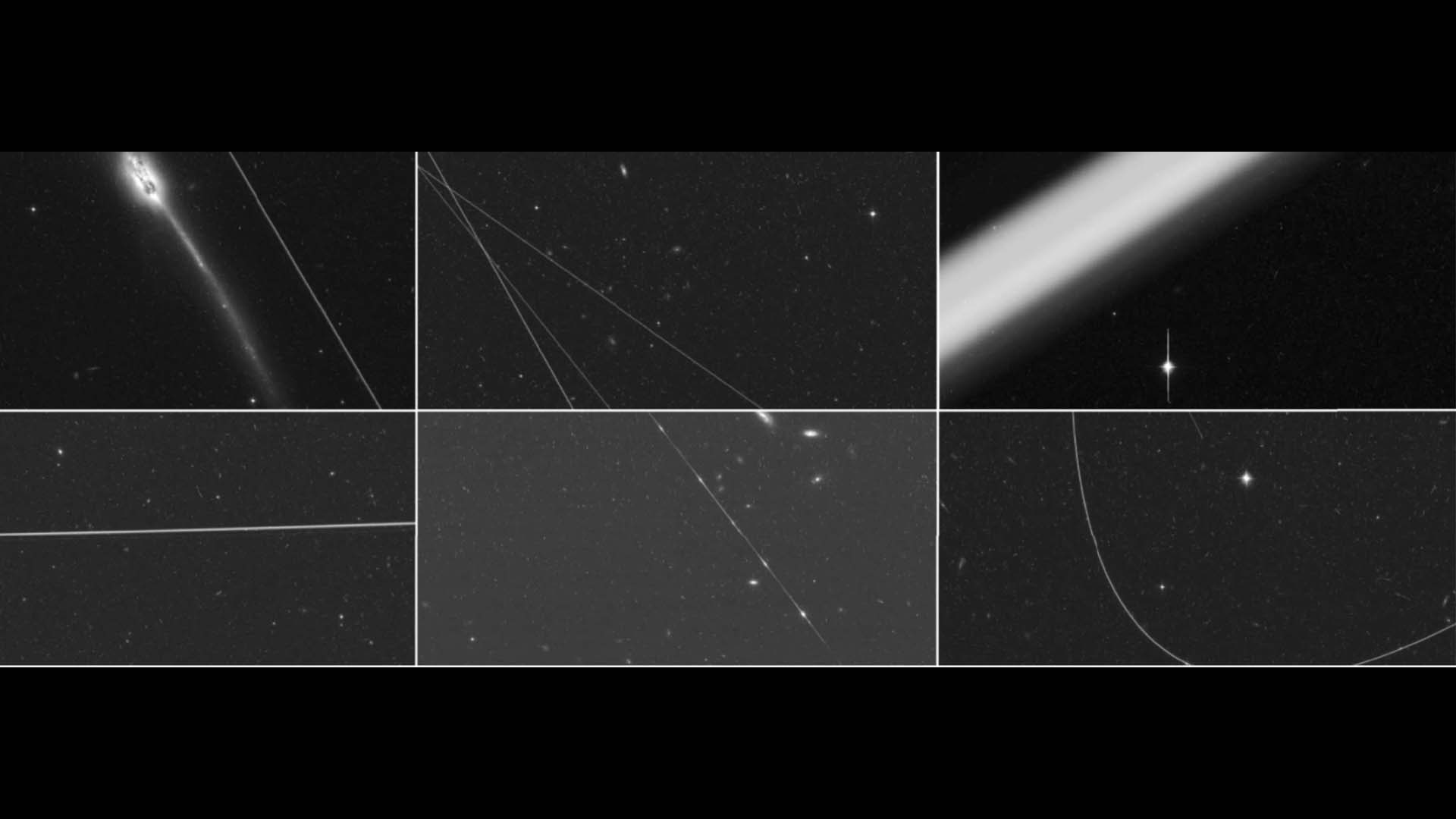Image of the Day: November 2011
Under the Stars, Tarantula
Wednesday, November 16, 2011: About 2,400 massive stars in the center of 30 Doradus, also known as the Tarantula Nebula, produce intense radiation and powerful winds as they blow off material. The star-forming region, 30 Doradus, represents one of the largest located close to the Milky Way, and it lies in the neighboring galaxy, the Large Magellanic Cloud. Multimillion-degree gas detected in X-rays comes from shock fronts similar to sonic booms formed by these stellar winds and by supernova explosions. This hot gas blasts out gigantic bubbles in the surrounding cooler gas and dust shown here in orange.
—Tom Chao
Out, Damned Spot!
Thursday, November 17, 2011: Probably the largest sunspot observed in several years appears in the center of the Sun (Nov. 6-8, 2011) as viewed by the Solar Dynamics Observatory spacecraft. Many smaller sunspots accompany his large sunspot. The large sunspot already propelled several medium- to large-sized solar flares, and has the potential to hurl out more. The large sunspot group extends more than 62,000 miles (100,000 km), and each dark core is larger than Earth.
—Tom Chao
Towering Overhead
Friday, November 18, 2011: The mobile launcher (ML) stands under fading light after completing a 4.2-mile journey from Kennedy's Vehicle Assembly Building to the launch pad on November 16, 2011. NASA will modify the 355-foot-tall ML structure, which took about two years to construct, to support the new Space Launch System.
— Tom Chao
Going Places
Monday, November 21, 2011: Graphics with a fun flavor highlight the Interactive Exploration Roadmap. Clicking on various exploration targets on the map (located here) allows the viewer to access information about the International Space Station, moon, near-Earth asteroids, Mars, Saturn, Jupiter, and other celestial destinations. Sadly, one mission featured on the roadmap, Phobos-Grunt, already experienced serious setbacks, and may not achieve its goals. The following space agencies participated in developing the roadmap: ASI (Italy), CNES (France), CSA (Canada), DLR (Germany), ESA (European Space Agency), ISRO (India), JAXA (Japan), (KARI (Republic of Korea), NASA (United States of America), NSAU (Ukraine), Roscosmos (Russia), UKSA (United Kingdom), all part of the International Space Exploration Coordination Group (ISECG).
— Tom Chao
Burnin' for You
Tuesday, November 22, 2011: The ISS Progress 42P supply vehicle (Russian designation M-10M) streaks across the sky after undocking from the International Space Station on October 29, 2011, as seen by astronauts on the ISS. The unmanned spacecraft is sent to the ISS carrying supplies, but after transferring the supplies, the crew fills the empty spacecraft with refuse, and sends it hurtling Earthward, incinerating both the spent spacecraft and the refuse.
— Tom Chao
Grand Designs
Wednesday, November 23, 2011: Large spiral galaxy Messier 74 lies 30 million light years away from the Earth, positioned face-on to us. Astronomers call Messier 74 a "grand design" spiral galaxy with well defined spiral arms. From here we see Messier 74 through a screen of foreground stars in our galaxy, the Milky Way, which bears resemblance to it.
— Tom Chao
Double Shot of My Baby's Coronal Mass Ejections
Thursday, November 24, 2011: Two coronal mass ejections blasted out of the sun almost right on top of each other, over about half a day as seen by the STEREO Behind spacecraft on Nov. 3-4, 2011. The first event heads away from Earth (positioned to the right of the combined coronagraphs image) and the second blast headed towards the spacecraft, with the expanding particles forming a halo around the Sun. In the combined image, the first event is the broad, lighter arc to the left, and the second event is the bright area above the Sun in the green area.
— Tom Chao
Breaking space news, the latest updates on rocket launches, skywatching events and more!
This Is a Test
Friday, November 25, 2011: NASA conducted a 500-second test firing of the J-2X rocket engine on Wednesday, Nov. 9, at NASA's Stennis Space Center in Mississippi.The test marked another step in the development of an upper stage for the heavy-lift Space Launch System (SLS).The engine uses liquid hydrogen and liquid oxygen propellants. This core stage engine was developed originally for the space shuttle. The J-2X engine is being developed by Pratt & Whitney Rocketdyne of Canoga Park, Calif.
— Tom Chao
I Feel Like Jonah in the Belly of the Whale
Monday, November 28, 2011: NGC 4631, known as the Whale Galaxy, lies about 30 million light-years away from us in the constellation of Canes Venatici (The Hunting Dogs), and is a spiral galaxy like the Milky Way. Profuse starbirth lights the galactic center, revealing bands of dark material between us and the starburst. From Earth, we see the Whale Galaxy edge-on, its profile suggesting an enormous cetacean.
— Tom Chao
Some People Say Not to Worry About the Air
Wednesday, November 30, 2011: Astronauts aboard the International Space Station took a picture on July 31, 2011 showing the layers of the Earth's atmosphere. The orange-red troposphere lies closest to Earth’s surface. A brown transitional layer marks the upper edge of the troposphere, the tropopause. A milky white and gray layer rests above that, likely part of the stratosphere possibly containing some noctilucent clouds. The upper atmosphere composed of the mesosphere, thermosphere, and exosphere fades from blue to the blackness of space.
— Tom Chao

Space.com is the premier source of space exploration, innovation and astronomy news, chronicling (and celebrating) humanity's ongoing expansion across the final frontier. Originally founded in 1999, Space.com is, and always has been, the passion of writers and editors who are space fans and also trained journalists. Our current news team consists of Editor-in-Chief Tariq Malik; Editor Hanneke Weitering, Senior Space Writer Mike Wall; Senior Writer Meghan Bartels; Senior Writer Chelsea Gohd, Senior Writer Tereza Pultarova and Staff Writer Alexander Cox, focusing on e-commerce. Senior Producer Steve Spaleta oversees our space videos, with Diana Whitcroft as our Social Media Editor.










